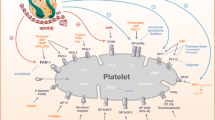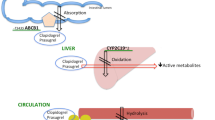Abstract
Lupus anticoagulants (LA) are a surrogate marker for the risk of thromboembolic disease (TE). However, not all individuals with LA acquire TE, and it is desirable to distinguish those at risk for TE from those without. Platelets polymorphisms may contribute to the risk of TE, mainly those of glycoprotein (GP)Ibα: these are the variable number of tandem repeats (VNTR) and a dimorphism in the Kozak region, which affect platelet plug formation in healthy individuals under high shear stress rates. We determined polymorphisms within the GPIbα in individuals with persistent LA and a history of TE (LA/TE+) and in those without TE (LA/TE-). Further, we measured platelet function, as estimated by the collagen-epinephrine closure time (CEPI-CT) of the platelet function analyzer PFA-100 and compared all data with healthy controls. There was no difference of the VNTR alleles compared to healthy controls. The (−5)C allele of the Kozak dimorphism was significantly more frequent in LA patients compared to controls (p = 0.04), as a result of its increased frequency in LA/TE+ (vs controls p = 0.04), but there was no difference between LA/TE+ and LA/TE−. The increased frequency of the (−5)C allele resulted in an overrepresentation of (−5)TC genotype in the LA/TE+ group (p = 0.02) but not in a subgroup of 18 patients with arterial disease. The CEPI-CT of the PFA-100 was shorter in LA/TE+ than in LA/TE− (p = 0.044), but this difference did not persist after exclusion of patients with low platelet counts or low ristocetin cofactor activity. Unlike in healthy individuals, the CEPI-CT was not related to any Kozak dimorphism, neither in LA/TE−, nor in LA/TE+. Thus, the Kozak dimorphism may just contribute to stronger factors disposing individuals with LA towards TE without any discernible effect on their in vitro platelet function estimated by the PFA-100.
Similar content being viewed by others
References
Love PE, Santoro SA (1990) Antiphospholipid antibodies: anticardiolipin and the lupus anticoagulant in systemic lupus erythematosus (SLE) and in non-SLE disorders. Prevalence and clinical significance. Ann Intern Med 112:682–698
Levine JS, Branch DW, Rauch J (2002) The antiphospholipid syndrome. N Engl J Med 346:752–763
Zoghlami-Rintelen C, Vormittag R, Sailer T, Lehr S, Quehenberger P, Rumpold H, Male C, Pabinger I (2005) The presence of IgG antibodies against beta2-glycoprotein I predicts the risk of thrombosis in patients with the lupus anticoagulant. J Thromb Haemost 3:1160–1165
Campbell AL, Pierangeli SS, Wellhausen S, Harris EN (1995) Comparison of the effects of anticardiolipin antibodies from patients with the antiphospholipid syndrome and with syphilis on platelet activation and aggregation. Thromb Haemost 73:529–534
Escolar G, Font J, Reverter JC, Lopez-Soto A, Garrido M, Cervera R, Ingelmo M, Castillo R, Ordinas A (1992) Plasma from systemic lupus erythematosus patients with antiphospholipid antibodies promotes platelet aggregation. Studies in a perfusion system. Arterioscler Thromb 12:196–200
Galli M, Bevers EM, Comfurius P, Barbui T, Zwaal RF (1993) Effect of antiphospholipid antibodies on procoagulant activity of activated platelets and platelet-derived microvesicles. Br J Haematol 83:466–472
Joseph JE, Harrison P, Mackie IJ, Isenberg DA, Machin SJ (2001) Increased circulating platelet-leucocyte complexes and platelet activation in patients with antiphospholipid syndrome, systemic lupus erythematosus and rheumatoid arthritis. Br J Haematol 115:451–459
Machin SJ (1996) Platelets and antiphospholipid antibodies. Lupus 5:386–387
Martinuzzo ME, Maclouf J, Carreras LO, Levy-Toledano S (1993) Antiphospholipid antibodies enhance thrombin-induced platelet activation and thromboxane formation. Thromb Haemost 70:667–671
Slupsky JR, Cawley JC, Griffith LS, Shaw AR, Zuzel M (1992) Role of Fc gamma RII in platelet activation by monoclonal antibodies. J Immunol 148:3189–3194
Wang L, Su CY, Chou KY, Wang CT (2002) Enhancement of human platelet activation by the combination of low concentrations of collagen and rabbit anticardiolipin antibodies. Br J Haematol 118:1152–1162
Arvieux J, Roussel B, Pouzol P, Colomb MG (1993) Platelet activating properties of murine monoclonal antibodies to beta 2-glycoprotein I. Thromb Haemost 70:336–341
Deckmyn H, Ulrichts H, Van De Walle G, Vanhoorelbeke K (2004) Platelet antigens and their function. Vox Sang 87(Suppl 2):105–111
Yee DL, Bray PF (2004) Clinical and functional consequences of platelet membrane glycoprotein polymorphisms. Semin Thromb Hemost 30:591–600
Lopez JA, Ludwig EH, McCarthy BJ (1992) Polymorphism of human glycoprotein Ib alpha results from a variable number of tandem repeats of a 13-amino acid sequence in the mucin-like macroglycopeptide region. Structure/function implications. J Biol Chem 267:10055–10061
Afshar-Kharghan V, Li CQ, Khoshnevis-Asl M, Lopez JA (1999) Kozak sequence polymorphism of the glycoprotein (GP) Ibalpha gene is a major determinant of the plasma membrane levels of the platelet GP Ib-IX-V complex. Blood 94:186–191
Jilma-Stohlawetz P, Homoncik M, Jilma B, Knechtelsdorfer M, Unger P, Mannhalter C, Santoso S, Panzer S (2003) Glycoprotein Ib polymorphisms influence platelet plug formation under high shear rates. Br J Haematol 120:652–655
Tan EM, Cohen AS, Fries JF, Masi AT, McShane DJ, Rothfield NF, Schaller JG, Talal N, Winchester RJ (1982) The 1982 revised criteria for the classification of systemic lupus erythematosus. Arthritis Rheum 25:1271–1277
Brandt JT, Triplett DA, Alving B, Scharrer I (1995) Criteria for the diagnosis of lupus anticoagulants: an update. On behalf of the Subcommittee on Lupus Anticoagulant/Antiphospholipid Antibody of the Scientific and Standardisation Committee of the ISTH. Thromb Haemost 74:1185–1190
Schallmoser K, Rosin C, Knittelfelder R, Sailer T, Ulrich S, Zoghlami C, Lehr S, Pabinger I, Panzer S (2005) The Fc gammaRIIa polymorphism R/H131, autoantibodies against the platelet receptors GPIb alpha and Fc gammaRIIa and a risk for thromboembolism in lupus anticoagulant patients. Thromb Haemost 93:544–548
Jilma B (2001) Platelet function analyzer (PFA-100): a tool to quantify congenital or acquired platelet dysfunction. J Lab Clin Med 138:152–163
Homoncik M, Jilma B, Hergovich N, Stohlawetz P, Panzer S, Speiser W (2000) Monitoring of aspirin (ASA) pharmacodynamics with the platelet function analyzer PFA-100. Thromb Haemost 83:316–321
Reiter RA, Mayr F, Blazicek H, Galehr E, Jilma-Stohlawetz P, Domanovits H, Jilma B (2003) Desmopressin antagonizes the in vitro platelet dysfunction induced by GPIIb/IIIa inhibitors and aspirin. Blood 102:4594–4599
Schallmoser K, Rosin C, Vormittag R, Brunner M, Dunkler D, Pabinger I, Panzer S (2006) Specificities of platelet autoantibodies and platelet activation in lupus anticoagulant patients: a relation to their history of thromboembolic disease. Lupus 15:507–514
Harrison P, Robinson MS, Mackie IJ, Joseph J, McDonald SJ, Liesner R, Savidge GF, Pasi J, Machin SJ (1999) Performance of the platelet function analyser PFA-100 in testing abnormalities of primary haemostasis. Blood Coagul Fibrinolysis 10:25–31
Out HJ, de Groot PG, van Vliet M, de Gast GC, Nieuwenhuis HK, Derksen RH (1991) Antibodies to platelets in patients with anti-phospholipid antibodies. Blood 77:2655–2659
Panzer S, Gschwandtner ME, Hutter D, Spitzauer S, Pabinger I (1997) Specificities of platelet autoantibodies in patients with lupus anticoagulants in primary antiphospholipid syndrome. Ann Hematol 74:239–242
Rock G, Chauhan K, Jamieson GA, Tandon NN (1994) Anti-CD36 antibodies in patients with lupus anticoagulant and thrombotic complications. Br J Haematol 88:878–880
Macchi L, Rispal P, Clofent-Sanchez G, Pellegrin JL, Nurden P, Leng B, Nurden AT (1997) Anti-platelet antibodies in patients with systemic lupus erythematosus and the primary antiphospholipid antibody syndrome: their relationship with the observed thrombocytopenia. Br J Haematol 98:336–341
Godeau B, Piette JC, Fromont P, Intrator L, Schaeffer A, Bierling P (1997) Specific antiplatelet glycoprotein autoantibodies are associated with the thrombocytopenia of primary antiphospholipid syndrome. Br J Haematol 98:873–879
Galli M, Daldossi M, Barbui T (1994) Anti-glycoprotein Ib/IX and IIb/IIIa antibodies in patients with antiphospholipid antibodies. Thromb Haemost 71:571–575
Levy Y, Shenkman B, Tamarin I, Pauzner R, Shoenfeld Y, Langevitz P, Savion N, Varon D (2005) Increased platelet deposition on extracellular matrix under flow conditions in patients with antiphospholipid syndrome who experience thrombotic events. Arthritis Rheum 52:4011–4017
Sailer T, Vormittag R, Pabinger I, Vukovich T, Lehr S, Quehenberger P, Panzer S, Lechner K, Zoghlami-Rintelen C (2005) Inflammation in patients with lupus anticoagulant and implications for thrombosis. J Rheumatol 32:462–468
Acknowledgment
The authors thank Silvia Koder for patients’ care and administration, Eva Guschlbauer and Peter Quehenberger for the determinations of von Willebrand Factor Antigen and Ristocetin Cofactor activity, and Beate Eichelberger and Daniela Koren for expert technical assistance.
This work was supported in part by a Grant from the Hochschuljubiläumsstiftung der Stadt Wien and by Grant 8647 from the Österreichischen Nationalbank to Simon Panzer, and by Grant 2027 of the Medizinisch-Wissenschaftlichen Fonds des Bürgermeisters der Bundeshauptstadt Wien to Ingrid Pabinger.
Author information
Authors and Affiliations
Corresponding author
Rights and permissions
About this article
Cite this article
Jilma-Stohlawetz, P., Jilma, B., Mannhalter, C. et al. Platelet glycoprotein Ibα polymorphisms and function evaluated by the platelet function analyzer PFA-100 in patients with lupus anticoagulant: the association with thromboembolic disease. Ann Hematol 86, 719–725 (2007). https://doi.org/10.1007/s00277-007-0341-3
Received:
Accepted:
Published:
Issue Date:
DOI: https://doi.org/10.1007/s00277-007-0341-3




